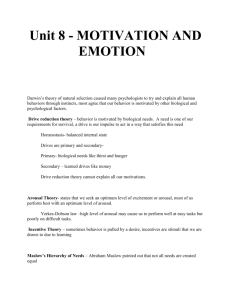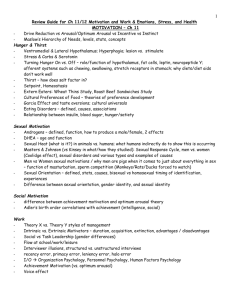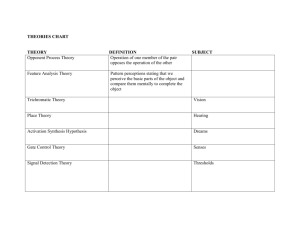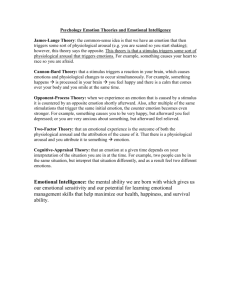Motivation & Emotion
advertisement
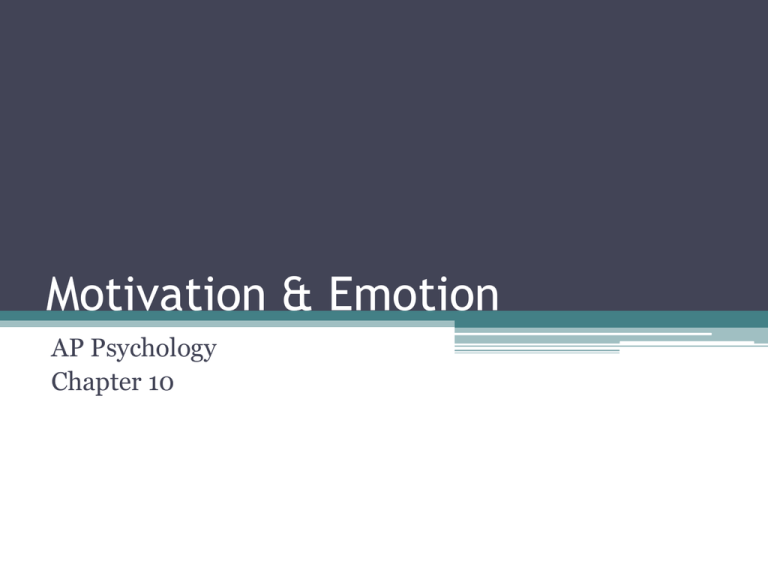
Motivation & Emotion AP Psychology Chapter 10 Emotion • Organized psychological and physiological reactions to changes in one’s relationship to the world. ▫ ▫ ▫ ▫ ▫ ▫ Transitory (not constant) Either positive or negative Dependent on cognitive appraisal of a situation Alter thought processes Create tendency towards certain actions Passions (not actions) because they occur whether you want them to or not The Brain’s Role in Emotion • Activity in the limbic system is important to the experience of emotion • Control over emotional and nonemotional facial expressions. • Hemispheric Differences – right hemisphere is more active in experiencing positive emotions Figure 11.11: The Autonomic Nervous System Autonomic nervous system controls physiological arousal Sympathetic division (arousing) Parasympathetic division (calming) Pupils dilate EYES Pupils contract Decreases SALIVATION Increases Perspires SKIN Dries Increases RESPIRATION Decreases Accelerates HEART Slows Inhibits DIGESTION Activates Secrete stress hormones ADRENAL GLANDS Decreases secretion of stress hormones Theories of Emotion • Does your heart pound because you are afraid….or are you afraid because you feel your heart pounding? James-Lange Theory of Emotion • We feel emotion because of biological changes caused by stress Sight of oncoming car (perception of stimulus) Pounding heart (arousal) Fear (emotion) Cannon-Bard Theory of Emotion Emotion-arousing stimuli simultaneously trigger: physiological responses Emotion Thalamus sends signals to the cortex and to our autonomic nervous system at the same time Sight of oncoming car (perception of stimulus) Pounding heart (arousal) Fear (emotion) Schachter’s Two-Factor Theory of physical Both our responses and our Emotion Pounding heart (arousal) Sight of oncoming car (perception of stimulus) Fear (emotion) Cognitive label “I’m afraid” cognitive labels (mental representations) combine to cause an emotional response Emotion depends on 2 factors: 1. Biology 2. Cognition Emotion- Lie Detectors Polygraph machine commonly used in attempts to detect lies measures several of the physiological responses accompanying emotion perspiration cardiovascular breathing changes Emotion-Lie Detectors Control Question Up to age 18, did you ever physically harm anyone? Relevant Question Did [the deceased] threaten to harm you in any way? Relevant > Control --> Lie Emotion-Lie Detectors Respiration Perspiration Heart rate Control Relevant question question (a) Control question Relevant question (b) Communicating Emotion • Facial movements and expressions – primary role ▫ Body cues and tone of voice play smaller role • Cultural affect on ways in which emotions are expressed – ▫ Japanese and North American people disagreed about which faces showed anger, disgust, and fear • Social referencing – people use another’s emotional state to determine how to react Culturally universal expressions Infants’ naturally occurring emotions What Is Motivation? • Factors that influence the initiation, direction, intensity, and persistence of behavior. • Motives – act as intervening variables – provide a single reason for the occurrence of behaviors • Sources of motivation: ▫ ▫ ▫ ▫ Biological Emotional Cognitive Social Drive Reduction Theory • Primary and secondary drives reduce biological needs caused by an imbalance in homeostasis • the idea that a physiological need creates an aroused tension state (a drive) that motivates an organism to satisfy the need • Need – a requirement for survival • Drive – our impulse to act in a way that satisfies the need Figure 11.3: Drive Reduction Theory and Homeostasis Need (e.g., for food, water) Drive (hunger, thirst) Drive-reducing behaviors (eating, drinking) Arousal Theory • People are motivated to maintain their optimal level of arousal ▫ Increase arousal when it is too low ▫ Decrease arousal when it is too high • Regulation of arousal • Yerkes-Dodson Law – performance at any task varies with arousal. At low arousal, people are lethargic and perform badly. As arousal increases, performance also increases - but only to a point, after which increasing arousal actually decreases performance. Opponent-Process Theory • People are usually at a normal, baseline state • We perform acts that move us from our baseline state, which are initially pleasurable • Eventually, we feel an opponent process, or motivation to return to our baseline, neutral state • Common with addictions – smoking, drinking, etc. Incentive Theory • Behavior is goalorientated • We behave in ways that allow us to attain desirable stimuli and avoid negative stimuli • We are motivated to seek rewards 3 Types of Motivation: • Hunger • Sexual • Achievement Hunger Motivation • Biological signals for hunger and satiety: Signals from stomach Signals from the blood • Hypothalamus – monitors and controls body chemistry – makes us feel hungry ▫ Hypothalamus is involved in the homeostatic maintenance of a set point • Ventromedial nucleus of the hypothalamus – stop eating • Lateral hypothalamus – “hunger center” – start eating Hunger Motivation – Psychological Factors • Nonbiological factors can override the brain’s regulatory processes. • Externals – motivated to eat by external food cues (attractiveness or availability of food) • Internals – less affected by the presence and presentation of food • Garcia Effect – occurs whenever nausea is paired with food or drink (classical conditioning – taste aversion) • Culture & background Eating Disorders: Obesity • Overweight by 100+ pounds • Possible Causes: ▫ Inadequate physical activity and overeating ▫ Genetic predisposition ▫ Psychological explanations • Losing Weight ▫ ▫ ▫ ▫ Diet Surgery Antiobesity medications Exercise Eating Disorders: Anorexia Nervosa • Characterized by behaviors resulting in weight loss below 85% of normal. ▫ About 95% of sufferers are young females. ▫ Despite hunger, refusal to eat. • Causes serious, often irreversible physical damage. Women’s Body Images Eating Disorders: Bulimia Nervosa • Intense fear of being fat, but may be thin, normal in weight, or even overweight. • Characterized by “binge-purge” episodes. • episodes of overeating, usually of high-calorie foods, followed by vomiting, laxative use, fasting, or excessive exercise • Majority of sufferers are women • Weight of a bulimic is normal or slightly above average Sexual Motivation • Sex ▫ a physiologically based motive, like hunger, but it is more affected by learning and values • Factors affecting sexual motivation and behavior include: ▫ Individual’s physiology. ▫ Learned behavior. ▫ The physical and social environment. Sexual Orientation • Nature of a person’s enduring emotional, romantic, or sexual attraction to others. • In many cultures, heterosexual is a moral norm. ▫ Homosexuality seen as a disease, a mental disorder, or a crime. • Attempts to alter sexual orientation of homosexuals usually ineffective. Achievement Motivation • Extrinsic vs. Intrinsic Motivation • Much of our behavior is motivated by a desire for esteem. • Need for Achievement – motivated to master tasks – raise the bar high ▫ Individual differences – high need to achieve vs. low need to achieve Development of Achievement Motivation • Tends to be learned, especially during early childhood. • Parental Influences • Cultural Influences • Effects of Beliefs About Oneself Goal Setting and Achievement Motivation • Goals established to reduce a discrepancy between current and desired situation. • In general, the more difficult the goal, the harder one will try to reach it. ▫ Goal must be attainable and valued. • Important to set clear and specific goals. Achievement and Success in the Workplace • Low motivation when one feels they have little or no control over work environment. • Ability to set and achieve clear goals can increase job performance and satisfaction. • Especially effective goals are: ▫ Personally meaningful. ▫ Specific and concrete. ▫ If supported by management. Achievement in the Workplace Theory X assumes that workers are basically lazy, errorprone, and extrinsically motivated by money workers should be directed from above Theory Y assumes that, given challenge and freedom, workers are motivated to achieve self-esteem and to demonstrate their competence and creativity Achievement and Subjective Well-Being • Subjective well-being is feeling satisfied with life, often having positive emotions • Subjective well-being tends to be relatively stable through life. ▫ Baseline level may be influenced by genetics. • What generates happiness? ▫ Close Social Ties ▫ Religious Faith ▫ Having necessary resources to allow progress toward one’s goals. Maslow’s Hierarchy of Needs begins at the base with physiological needs that must first be satisfied then higher-level safety needs become active then psychological needs become active Conflicting Motives & Stress • Four basic types of motivational conflicts: ▫ ▫ ▫ ▫ Approach-approach Avoidance-avoidance Approach-avoidance Multiple approach-avoidance • Conflicts can create significant stress.

